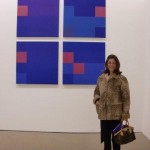the people who put posters in public places around city centres of famous art works (voted for by the public), have commissioned Antony Gormley to produce this drawing. Created by the artist using the stylus in one continuous motion on an iPad, Gormley says, “I’ve never drawn on an iPad before and was thinking should I draw on a blackened piece of glass? Then I thought this is really stupid, we’ve got this extraordinary facility that everybody knows about [..] so why don’t I give it a try?”
I think the end result is really quite fun. Only time will tell if this marks a new direction for this veteran of the British art establishment. Antony Gormley tells me that for several years he’s been using the digital as tools – all his sculptures start ‘life’ in the computer. 3D scans of his body facilitates manipulation of forms digitally, giving countless permutations and allowing valuable feedback. He also uses 3D printers. A new way of approaching the maquette?
You can see the work, which also consists of the animation of its creation, on digital screens nationwide including Piccadilly Circus & Manchester’s Trafford Centre, supported by the The Art Fund. Downloads and limited edition prints are available.











